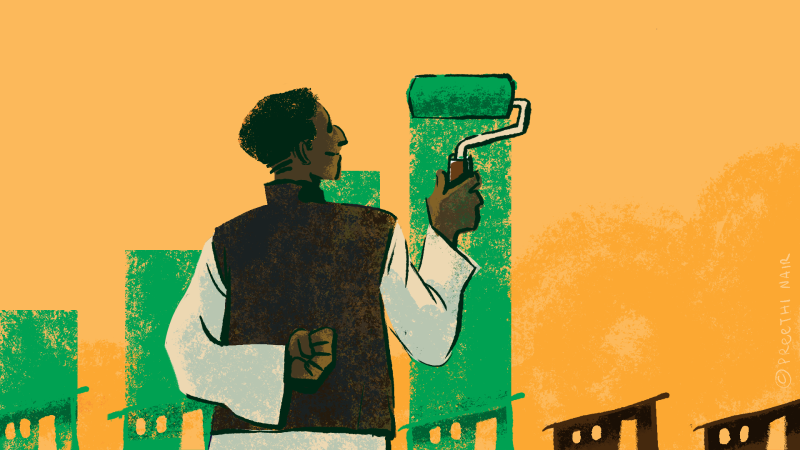Between Development and Forced Eviction
Published on

Between Development and Forced Eviction: How Kaala (2018) fights the good fight?
by Barathi Selvam
P.A Ranjith’s directorial venture, Kaala (2018), was set against a political climate where India’s political leadership succumbed to a party imbibing the Hidutva(1) ideology. Indian superstar Rajnikanth’s merger with the progressive filmmaker accelerated the commercial value for ‘status-quo disrupting’ films that are currently gaining traction amongst audiences.
Kaala narrates the story of a slum population residing in Dharavi, Mumbai that houses tens of thousands of migrants from various parts of India. Their blood, sweat and tears transformed the jungles, swamps and mountains into urban cities as we know of today.
The discourse of the movie can be distinguished into two parts. Firstly, a relentless battle between the working class people of the slums and capitalists backed by political powers interested in Dharavi’s residential land. This segment of the movie sparks parallel comparison between the movie and the struggle of the urban pioneers (traditionally labelled as squatters) and estate workers in Malaysia as the nexus between the two is rooted in the survivability of the working class against money-minded capitalists in cohort with political parasites. Secondly, and interestingly, the ideological contestation between good and evil.
Defending the Land
Similar to the film, evacuation efforts in real life situations such as in Malaysia begin mildly and transpire in stages. Initial evacuation methods include relocation compensation for the displaced families or else promises of alternate housing. The former would only be sufficient to cover transportation costs while the latter is often either to low-cost houses (normally flats) or houses far from their original location. Both measures are insufficient since they do not compensate for the immense value contributed by the people to the land, its surroundings, and the development of the nation. Moreover, bearing in mind the practices of forced eviction goes directly against international human rights standards. The United Nations Committee on Economic, Social and Cultural Right stated the freedom or right to adequate housing must be inclusive of “protection against forced eviction and the arbitrary destruction and demolition of one’s home.” (2)
Yet, Refusing to evacuate will result in civil, mostly uncivilised, reprisals from the developers in cohort with government and state’s machineries. Quite an irony, as the responsibility to protect the working class from forced evictions and ensure their right to adequate housing lies within the government. Amongst the resolution taken in 1992/14 by the Committee on Human Rights, it “urges the Governments to confer legal security of tenure on all persons currently threatened with forced eviction and to adopt all necessary measures giving full protection against forced eviction, based upon effective participation, consultation and negotiation with affected persons or groups.” The protective measures rarely materialise.
In Kaala, the forced evacuees deployed themselves as a barricade between their houses and evicting forces. This aspect of collective struggle was well understood by P.A Ranjith who internalised left-wing ideologies. Bayard Rustin's(3) philosophy “the only weapon we have is our bodies” is transliterated in the movie. Kaala progresses from individual heroism typical in Rajnikanth’s films to the collective strength of the masses instead. The people of numerous backgrounds understood that the fate of their land lay in the hands of the collective, only if they fought together.
A glimpse of Forced Eviction in Malaysia
The scenario depicted in the film is not fictitious but rather a mirror of historical accounts of forced evictions and the entailing struggles that have been captured in Malaysian resources such as Braemar: Bila Perempuan Tua dan Anak Muda Bangkit (Braemar: When Elderly Women and Youths Rise)(2013), Akar Umbi: Kisah Perjuangan Rakyat Menentang Ketamakan Kapitalis (Grassroots: People’s Struggle Resisting Capitalist Greed)(2019), Bila Singa Ditumpaskan: Kisah Kemenangan Pekerja Ladang Brooklands (Defeating the Lion: The Victory of Brooklands’ Estate Workers) (2008)and Kuasa Rakyat Menang di Kg Chekkadi (People’s Power Wins in Kg Chekkadi) (2009). These books articulate the extent, tactics and alliances concocted by the rich and powerful to evict people from their generational habitat. Although it violates universal human rights values, the fraternisation between capitalist developers and ruling politicians disregards the people’s plight.
Braemar Estate (located in Kajang, Malaysia) workers, for instance, were involved in 14 long years of relentless struggle. Disruption of essential services, harassment from gangsters, countless incidents of police intimidation and detention were some of the common occurrences for the families in their course of struggle. Besides, they also had to face the despair of loss and mourning over friends and family who succumbed to an untimely demise. Time has invariably consumed their youth, age, sweat and blood, but those who dared to fight for their rights had succeeded, despite the financial and physical strength the oppressive sides might have. Nevertheless, consistency and perseverance led them to be awarded free houses as their rightful compensation.
Black vs White = Bad vs Evil?
Secondly, Kaala touches on the ideological dispute between good and evil. Wittingly, the filmmaker chose to signify those concepts through the colours black and white. As portrayed in Kaala, Dharavi folks are minorities from different corners of the nation. Kaala, which is also the name of the protagonist Rajnikanth, is depicted in black attire instead of the antagonist’s milky white attire. In Hindu mythologies or epics, good, pure or divine virtues are equated with white. Bad, evil and ill omens are contrastingly associated with black. An uncritical viewership leaves a docile effect since the association of positive virtues with specific colours appear unproblematic, normal and even validated.
In Kaala, P.A Ranjith unearthed questions whether appearances, attires and skin colours are valid justifications to represent or express purity and other positive virtues? The fair-skinned antagonist is a political leader of high socio-economic status dressed in white. His demeanour embellished in caste superiority is reflected when he declines a drink offered at Kaala’s house. The so-called noble religious teachings that the character is shown to educate the younger generation of his household did not seem to translate in his actions. There was no remorse in him abusing his power or deploying the thugs at his disposal to execute his inhumane orders.
Conversely, the black-clothed and dark-skinned Kaala (Rajnikanth) and his compatriots were defendants of the people’s rights, justice renderers and placing humanity above enmity. Kaala is depicted as a protector of the oppressed community. His affinity for violence is born out of necessity as a form of self-defence, like Mario Puzo’s Godfather, where violence is a justice rendering tool.
The clash between black and white, powerless and powerful, poor and rich, oppressed and oppressors are visually juxtaposed throughout the movie. The viewers are presented with a depiction of contrasting characters, providing opportunities for them to evaluate and contemplate century-old social-constructs. However, this is not the first time the notion of purity has been questioned in artistic forms. The ace-filmmaker Maniratnam dealt with a similar ideological debate by juxtaposing his film characters (Raavanan, 2010) with opposite colours.
Around the world, the efforts of the oppressed communities in living with fundamental dignity are trampled by the rich and powerful. Some are guided by caste affinities, religious dogmatism, ethnic affiliation or gender chauvinism. These tangible and intangible dissimilarities are to be cherished, celebrated and regarded as a fortunate opportunity to learn the vast diversity humankind and this ecosystem has to offer.
Trading human values for spite, hatred, wealth and power that compromises the essence of a maturing society will only lead to the creation of an imbalanced society deprived of peace and stability.
A world without forced eviction?
Almost three decades have passed since the monumental Commission of Human Rights (1993/77)(4) condemned the act of forced evictions which unlawfully detaches the inhabitants from their habitat. The Committee affirmed that the “practice of forced eviction constitutes a gross violation of human rights, in particular the right to adequate housing.” However, in many parts of the world, including Malaysia, finds it convenient to appropriate these lands inhabited and cultivated by the pioneers instead of complying to the rights enshrined under the international standards as forced evictions are still carried out either violently or cunningly, or both combined.
This merciless action failed to question the conscience of the capitalist class, neither the ruling regime. Recent cases of forced evictions or threats of displacement in places such as Winsor Estate workers, farmers of Chepor Impian and Bagan Lalang’s Indigenous Community(5) demonstrates the only path lies ahead for the working class is to unite, organise and fight for their rights.
Much recently, I had a conversation with the veteran social activist and the former chairman of Parti Sosialis Malaysia, Dr. Nasir Hashim who coined the word ‘Urban Pioneers’ in the struggle against forced eviction about an abstract cover page illustration of a novel authored by him, Mengharungi Titik Noktah. I shall end this writing with an explanation (rather a question) of the illustration which was also his own drawing in the style of Cubism (Picasso’s style): “the eye represents the person trapped by the encircling development, development for whom we wonder?”

Notes:
(1)Hindutva is the name by which the ideology of the Hindu right, represented by the political party Bharatiya Janata Party, or Indian People’s Party (BJP), is known. It is also the ideology of the cultural body known as Rashtriya Swayamsevak Sangh, or National Volunteer Core (RSS). Sharma, A. (2020). On the difference between Hinduism and Hindutva. Asian Philosophies and Religions. Vol. 25(1).
(2)The Human Right to Adequate Housing, United Nations Human Rights Office of the High Commissioner. https://www.ohchr.org/en/special-procedures/sr-housing/human-right-adequate-housing
(3)Rustin is a close advisor to Martin Luther King and an influential and effective organisers of the civil rights movement. See https://kinginstitute.stanford.edu/encyclopedia/rustin-bayard
(4)UN Commission on Human Rights, Forced evictions., 10 March 1993, E/CN.4/RES/1993/77, available at: https://www.refworld.org/docid/3b00f0c514.html
(5)Donald, R. (2021, August 20). They safeguarded nature, but now Malaysia’s Mah Meri face eviction for an eco-resort. https://news.mongabay.com/2021/08/they-safeguarded-nature-but-now-malaysias-mah-meri-face-eviction-for-an-eco-resort/